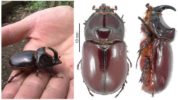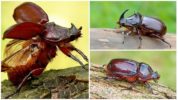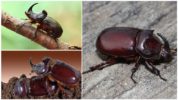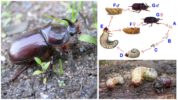- Rhinoceros beetle
- Rhinoceros beetle
- Rhino beetle habitat
- Rhino Beetle Development Stages
Rhinoceros beetles are so nicknamed for outgrowths on the front of the body. Not all “rhinos” have a horn located on their heads or in a single copy. Even insects belong to different genera. Their only common feature: they are all representatives of the subfamily of beetle duples (Dynastinae).
General characteristics
Rhinoceros beetles are common throughout the world, but the largest number are found in South America. In second place is Africa, then Australia. In last place is the Eurasian Palearctic region, where only 65 species of rhinos live - 5% of the total number of open species.
Interesting!
Hollows are among the largest beetles on the planet. But the size of insects is very different: from 2.5 cm to 17.2 cm.
The general characteristics include the appearance and food preferences of their larvae. Like all lamellar-like, rhinoceros larvae are C-shaped. Most species feed on rotting organics, but in some rhinos, the larvae eat the roots of living plants, causing serious damage to agriculture.
Due to the addiction of larvae to eating rotting wood, some species were able to leave the forests and adapt to life in the steppes. In such an unfavorable habitat, larvae eat dead plant roots.
Other southern dendrophilous species of beetles are able to eat living wood. Because of this, many rhinos are pests of various types of palm trees.
Species diversity
Due to the variety of beetles and their inaccessible habitats, it makes no sense to list all of these species. The list is worth those with whom people may encounter on tourist trips, when kept in insectarians or just for a walk in the forest. The most common is the Eurasian species of rhino duplyak.
Interesting!
Of the 65 species of the subfamily Dynastinae in the Palearctic region, only five ranges coincide with other zoogeographic territories. The remaining 60 are endemic to the Palearctic.
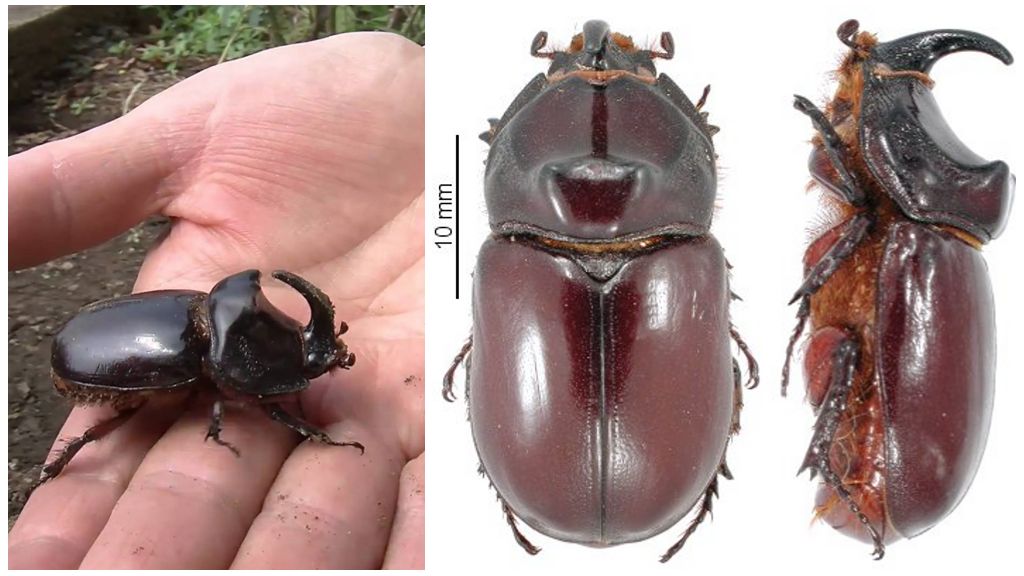
Rhino duplyak
The species, which gave the name to the entire subfamily of duplyaks. Belongs to the genus Oryctes or diggers. Biological names of the species:
- rhinoceros beetle;
- common rhinoceros beetle;
- hollow rhino.
The Latin name is Oryctes nasicornis. The Oryctes genus includes another 40 species of beetles. 7 of them live in the Palaearctic region and 5 of them are endemic.
Habitat and habitat
The species is widespread in the relatively warm regions of Eurasia:
- all of Europe;
- North Africa;
- Caucasus;
- Western Siberia, in the southern part;
- Asia Minor;
- Middle Asia;
- Northeast Turkey.
In Russia, the northern border of the range passes through the Leningrad, Novgorod, Kirov regions and through Bashkiria. Beyond the Urals, rhinoceros is found in the Sverdlovsk and Kustanai regions. In the east, the range reaches China.
The habitat of the insect is broad-leaved forest. In the Crimea and Ciscaucasia, it is often found in the forest-steppe and steppe zones. In Kazakhstan and Central Asia, the common rhino managed to penetrate the steppe and semi-desert zones, where it became an optional synanthropus.
In these regions, a rhinoceros beetle larva develops in greenhouses, sawdust, and compost pits. Eating rotting organic matter, the larva brings considerable benefits in obtaining fertilizers.In the north of Europe and in the West Siberian taiga, the insect penetrated together with humans. In these areas it leads the same lifestyle as in Central Asia.
Important!
Due to the felling of broadleaf leaves, the number of rhinoceros beetles is reduced.
In some regions of Russia, this species is rare and is listed in the regional Red Books. In Belarus, this insect is also very rare. It is highly likely that it flies there accidentally with a fair wind. Rhinos fly very well, although they do not strike with aerobatics. A beetle crashing at a speed of 50 km / h into a person causes a sensation of electric discharge, which is why a myth arose about the ability of a rhino to accumulate static electricity during flight.

Beetle description
The northern Russian population is large beetles reaching sizes of 4.3 cm. The minimum size of the male is 2.5 cm. The females are slightly smaller: 2.6-4 cm. The color is brown with different shades. The lower body is lighter with a yellow tint. The top of the insect has a strong luster without a metallic tint. The body is oblong, wide.
Rhinos have pronounced sexual dimorphism: a beetle with one horn on its head is a male, and a horn is missing - a female. The male on the pronotum has a notch “under the horn”. The larger and stronger the male, the better his horn is developed. In weak males unsuitable for reproduction, the horn is poorly developed. Often the size of it does not exceed the horn of a female.
In the female, the proud name of the horn is a very small protrusion on the head. Pronotum not very well developed. In the photo of rhinoceros beetles of both sexes, the differences are clearly visible
Interesting!
The front part of the male in profile is really in shape similar to the head of a rhino.
The southern population of the small-sized rhino-hollow. Males do not exceed 3 cm. Brown beetles in this population. The males have small horns. Females are completely absent. The pronotum of the female also has no notches. The population and lifestyle are different.
Beetles are not dangerous to humans, in list of the most dangerous insects not listed, but they belong to the genus of diggers and have decent strength. If you hold the rhino in a fist, it can cause very unpleasant sensations with the front legs. In an attempt to get out, the beetle will scratch its palm.
Duration and lifestyle
With the widespread occurrence of the common rhinoceros beetle, it is poorly studied. We were able to determine the area. But there are still heated debates over the questions of what eats and if it eats at all, how long the rhinoceros beetle lives, and the timing of development.
Attempts to contain this insect at home have shown that the life expectancy of adults is no more than 2 months. But the insects were starving. Whether they really do not eat anything in captivity or the lovers were unable to find the right food for them, is unknown. The poor development of the oral apparatus suggests that the beetles eat juice or do not eat at all.
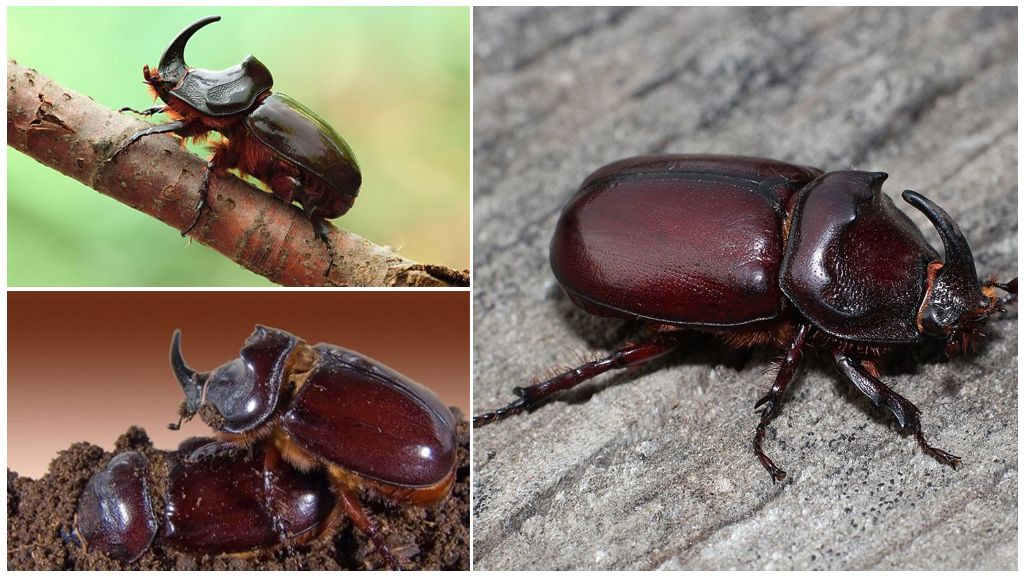
For this reason, keeping them as pets is pointless. The lover will receive a sluggishly moving insect. Not growing, not shedding and dying after a couple of months.
The southern population does not live at all even in nature. Adults fly out at night after the first heavy rain for mating. After that, the female rhinoceros beetle buries itself in the ground, where it lays eggs, and the males die. The life span of the southern beetles is one day.
On a note!
Rhinoceros beetles cannot swim and are afraid of water. This is due to their massive appearance after rain. Water floods their shelters. But insects have an adaptive mechanism in order to be able to wait for the night after a morning rainfall: they can remain motionless in the water for a long time. Such individuals look dead, but if they are removed from the water, they immediately begin to crawl.
In both cases, only the rhino beetle larva hibernates. Its development takes several years.
Larva
The years of the northern population begin in May. South - in August-September after the first heavy rain. A fertilized female lays eggs in rotten wood.Females of the southern population - to the ground.
The emergence of larvae occurs a month after laying. After leaving the egg, the larva remains in a nutrient medium: rotten wood or underground. The timing of the development of the larva is also not reliably established. It is believed that its life cycle takes 2-3 years.
On a note!
Southern larvae sometimes leave underground shelters if heavy rains occur for several days in a row.
The larvae of the rhinoceros and the May beetle are very similar:
- C-shaped;
- long paws;
- very large head;
- white body color with dark intestinal contents in the back.
If you look at the head of a rhino larva in close-up, you can see the powerful mandibles with which it grinds food. With a lack of dead organics, these insects are able to feed on the live roots of plants.
Rhino larvae grow significantly larger than adults. In the final stage of development, they reach 10-12 cm. If you take such a "worm" in your hands, it can bite. But with powerful stings that could pierce the skin, the larvae bite slightly. Due to the fact that powerful ticks are not able to open wide.

Other species
Other types of beetles having chitinous outgrowths on their heads are also called rhinos. Although among them it is often already possible to meet not unicorns, but two and three horns. Since these individuals look exotic, but do not live long, collectors willingly buy them in dried form. How much a rhinoceros beetle costs depends on its type and rarity. The common rhinoceros beetle, which is larger than usual, was sold for $ 10. But "as if alive."
Relatively common types of rhinos that are easy to buy:
- palm rhinoceros beetle (Oryctes rhinoceros);
- elephant beetle (Megasoma elephas);
- Japanese rhinoceros beetle (Trypoxylus dichotomus);
- Australian rhinoceros beetle (Xylotrupes ulysses).
Palm rhinoceros looks like an ordinary rhino-hollow. But its larvae are able to eat living wood, which is why this species is believed to be a pest.
Interesting!
The elephant beetle is one of the largest representatives of the subfamily duply. The length of the male along with the horn is up to 12 cm. The length of the female is 7 cm. The weight of the insect is up to 35 g. The main horn of the male is on the head, but on the pronotum there are 4 more short outgrowths directed forward. The female has no horns. They live in the tropical forests of Central and South America.
The Japanese rhinoceros beetle is a very large insect. Together with the horn, the body length of the male is up to 8.2 cm. The female is up to 4.7 cm. The main horn is directed forward and upward. It has a peculiar shape: initially trihedral, the horn is flattened towards the end and divided into two processes, which also bifurcate. In addition to the main horn, the Japanese beetle has another, growing from the middle of the pronotum towards the main one.
The Australian rhino has an original side view: the horn on the nose has a rounded shape that grows backward. From the back, towards the main horn two massive outgrowths are directed. Because of this structure, the head of the Australian rhino looks massive and cuboid. And the horns seem like an open handle for this drawer.
